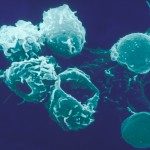Link to Pubmed [PMID] – 18403646
J. Leukoc. Biol. 2008 Jul;84(1):152-61
For the formation of lymph nodes and Peyer’s patches, lymphoid tissue inducer (LTi) cells are crucial in triggering stromal cells to recruit and retain hematopoietic cells. Although LTi cells have been observed in fetal spleen, not much is known about fetal spleen development and the role of LTi cells in this process. Here, we show that LTi cells collect in a periarteriolar manner in fetal spleen at the periphery of the white pulp anlagen. Expression of the homeostatic chemokines can be detected in stromal and endothelial cells, suggesting that LTi cells are attracted by these chemokines. As lymphotoxin (LT)alpha1beta2 can be detected on B cells but not LTi cells in neonatal spleen, starting at 4 days after birth, the earliest formation of the white pulp in fetal spleen occurs in a LTalpha1beta2-independent manner. The postnatal development of the splenic white pulp, involving the influx of T cells, depends on LTalpha1beta2 expressed by B cells.


